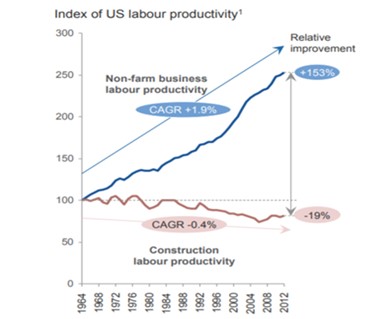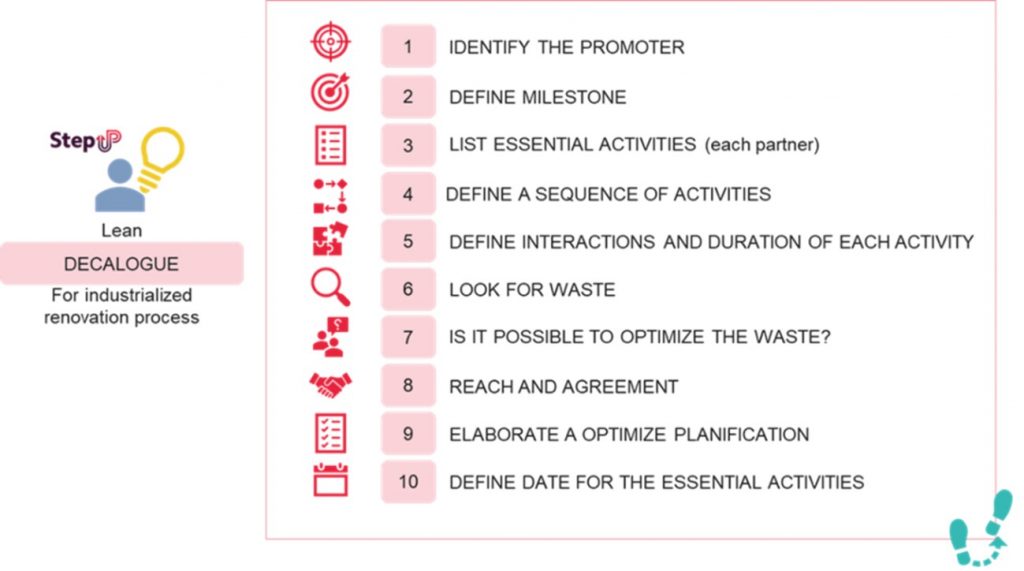Lean Metholodology for building renovation projects

Encouraged by the situation in recent years, the construction sector is undergoing a series of changes aimed at bringing its activity equal to the productivity levels of other industrial sectors.
As can be seen in the following Figure 1 (the figure shows the productivity data of the construction sector in the United States, although they are extensive to Europe and other advanced countries), it is paradoxical that the evolution of productivity in the construction sector is not only not comparable to that of other sectors, but, in addition, it has been reduced by almost 20% compared to the figures of the sixties of the last century.

Figure 1. Evolution of the productivity of the industrial sector compared to the construction sector in the United States
The productivity problem is probably the most representative of the sector. However, there are other conditions associated with it, which also have a great influence:
- For some years now, a worrying lack of qualified labour has been observed.
- There is a high increase in the costs of construction materials.
- At the same time, the trend of investors is to shorten the execution times, to optimize the financial costs of their real-estate developments.
- Construction is an activity with an enormous capacity to generate data, although these are not usually presented in a systematic and structured way, which greatly hinders their analysis and, therefore, the ability to obtain a benefit from them.
Regarding these arguments, it is evident that the sector needs the development of new strategies and tools that allow it to adapt to the current situation and demands of the sector. In this context, some global trends, such as industrialization or digitalization, have been identified as the key points to improve and optimize the construction sector and its processes.
Data-driven technology can help construction companies make smarter management decisions, reduce risk, and improve project results. The use of this type of tools, therefore, results in a higher success rate of the projects of these companies. Having extensive, precise and, above all, structured information allows construction companies to make more precise offers, plan more efficiently and hire the best subcontractors. In other words, these tools can help construction to increase its productivity.
However, they have little real implementation, precisely due to the lack of adequate methodological and technological support.
One of the methodologies that have been emerging in the recent years is Lean Construction. Its main objectives and tools will be explained in the following sections.
Lean Construction. Construction Without Waste
The evolution of the model known as Lean Manufacturing in the construction sector gave rise to the Lean Construction methodology.
In fact, Lean Construction follows the same principles of continuous improvement as Lean Manufacturing but in construction project management. Lean Philosophy proposes a new production model based on minimizing losses and maximize the value of the final product.
One of the most important objectives of Lean is to eliminate all waste. In other words, erasing every aspect that does not add value to the project. There are different types of waste as well as different interpretations of those types. However, we have chosen the following seven categories of waste:
- Overproduction; producing more (or faster) than is actually required.
- Waiting; downtime between two processes.
- Transportation; moving materials from one location to another.
- Overprocessing; putting in the product/project more than it is required or expected by the customer.
- Movement; unnecessary movements of machinery or employees.
- Inventory; each raw material or item in progress of manufacture or already finished that implies a cost until it is sold
- Defects; any error that requires time and/or resources to be fixed
With the application of different techniques and tools (such as Last Planner System (LPS), the 5S, the A3 report, Kanban, Value Stream Mapping, Lean Project Delivery System), Lean Construction manages to increase the productivity of construction processes and improve the profitability of the project.
Last Planner System (LPS)
LPS is one of the existing tools to apply Lean Construction on site. It is a work planning methodology that modifies the scheduling and control process, reducing uncertainty and variability. LPS[iii] represents a big change from managing activities to managing people.
To implement this tool correctly on site, it is essential to have a rigorous knowledge of the evolution of the work. Besides, the use of LPS generates a large amount of date related to productivity. For this reason, it makes technologies such as Artificial Intelligence and Big Data perfect allies to generate added value for customers who use them.
StepUP Lean approach for renovation projects
Considering all the previous analysis of the Lean Construction methodology, the StepUP consortium have detected some unexpected gaps in the application of Lean methodology that are relevant for the StepUP project:
- Its application is practically null in renovation projects.
- All aspects related to the manufacturing, shipping and assembly of the industrialized elements are not usually included in the process.
- Design process, monitoring or development of new business models are neither considered in the methodology.
That is the reason why, in the StepUP project, we will go one step further within this new philosophy, generating new knowledge and techniques to face the peculiarities of industrialized renovation processes.
For that purpose, a workshop was carried out with all the StepUP partners, where the strategy to be developed during the execution of the pilots was established, and a decalogue (Figure 2) was created as a roadmap to apply a lean approach to any industrialized renovation process.

Figure 2. Lean Decalogue for industrialized renovation processes
The lean decalogue defined in Figure 2 indicates, in chronological order, the steps and actions essentials to analyse and plan any renovation project under a lean approach, especially focus on detecting and avoiding any type of waste.
This analysis contributes with a key guidance of Lean Construction methodology to be implemented in industrialized renovation processes. That means an important challenge for the implementation of new Lean techniques.
Besides, based on this previous analysis and the results obtained from its future application in the StepUP project pilots, a public guideline will be designed and developed for the implementation of Lean Construction methodology in any building renovation process.
Authors: Manolo Gonzalez (Technical director of Construcciones ACR); Dr. María Ibáñez-Puy (Head of R&D projects of Construcciones ACR).
[1] Koskela, L. (1992). Application of the new production philosophy to construction (No. 72). Stanford, CA: Stanford university
[1] Womack, J. P., & Jones, D. T. (1996). Lean thinking: Banish waste and create wealth in your organisation. Simon and Shuster, New York, NY, 397
[1] Ballard, G. (2000). The Last Planner(TM) System of Production Control. Doctoral thesis, University of Birmingham, School of Civil Engineering. Birmingham, U.K.
 This project has received funding from the European Union’s Horizon 2020 research and innovation programme under grant agreement no. 847053.
This project has received funding from the European Union’s Horizon 2020 research and innovation programme under grant agreement no. 847053.
This website reflects only the author’s views. The European Climate, Infrastructure and Environment Executive Agency is not responsible for any use that may be made of the information it contains.
